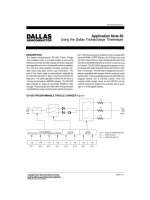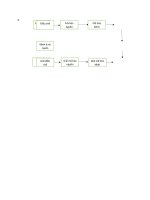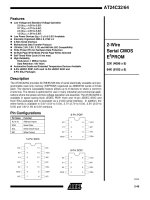Điện tử viễn thông lect09 1 khotailieu
Bạn đang xem bản rút gọn của tài liệu. Xem và tải ngay bản đầy đủ của tài liệu tại đây (685 KB, 32 trang )
9. Sharing systems
lect09.ppt
S-38.1145 – Introduction to Teletraffic Theory – Spring 2006
1
9. Sharing systems
Contents
•
Refresher: Simple teletraffic model
•
•
M/M/1-PS (∞ customers, 1 server, ∞ customer places)
M/M/n-PS (∞ customers, n servers, ∞ customer places)
•
Application to flow level modelling of elastic data traffic
•
M/M/1/k/k-PS (k customers, 1 server, k customer places)
2
9. Sharing systems
Simple teletraffic model
•
Customers arrive at rate λ (customers per time unit)
– 1/λ = average inter-arrival time
•
Customers are served by n parallel servers
•
When busy, a server serves at rate µ (customers per time unit)
– 1/µ = average service time of a customer
•
There are n + m customer places in the system
– at least n service places and at most m waiting places
It is assumed that blocked customers (arriving in a full system) are lost
•
λ
n+m
µ1
µ
µ
µ
n
3
9. Sharing systems
Pure sharing system
•
Finite number of servers (n < ∞), infinite number of service places
(n + m = ∞), no waiting places
– If there are at most n customers in the system (x ≤ n), each customer has
its own server. Otherwise (x > n), the total service rate (nµ) is shared fairly
among all customers.
– Thus, the rate at which a customer is served equals min{µ,nµ/x}
– No customers are lost, and no one needs to wait before the service.
– But the delay is the greater, the more there are customers in the system.
Thus, delay is an interesing measure from the customer’s point of view.
λ
∞
µ1
µ
µ
µ
n
4
9. Sharing systems
Contents
•
Refresher: Simple teletraffic model
•
•
M/M/1-PS (∞ customers, 1 server, ∞ customer places)
M/M/n-PS (∞ customers, n servers, ∞ customer places)
•
Application to flow level modelling of elastic data traffic
•
M/M/1/k/k-PS (k customers, 1 server, k customer places)
5
9. Sharing systems
M/M/1-PS queue
•
Consider the following simple teletraffic model:
– Infinite number of independent customers (k = ∞)
– Interarrival times are IID and exponentially distributed with mean 1/λ
• so, customers arrive according to a Poisson process with intensity λ
– One server (n = 1)
– Service requirements are IID and exponentially distributed with mean 1/µ
– Infinite number of customer places (p = ∞)
– Queueing discipline: PS. All customers are served simultaneously in a fair
way with equal shares of the service capacity µ.
•
•
Using Kendall’s notation, this is an M/M/1-PS queue
Notation:
– ρ = λ/µ = traffic load
6
9. Sharing systems
State transition diagram
•
Let X(t) denote the number of customers in the system at time t
– Assume that X(t) = i at some time t, and
consider what happens during a short time interval (t, t+h]:
• with prob. λh + o(h),
a new customer arrives (state transition i → i+1)
• if i > 0, then, with prob. i(µ/i)h + o(h) = µh + o(h),
a customer leaves the system (state transition i → i−1)
•
Process X(t) is clearly a Markov process with state transition diagram
0
•
λ
µ
1
λ
µ
2
λ
µ
Note that this is the same irreducible birth-death process with an infinite
state space S = {0,1,2,...} as for the M/M/1-FIFO queue.
7
9. Sharing systems
Equilibrium distribution (1)
•
Local balance equations (LBE):
π i λ = π i +1µ
(LBE)
⇒ π i +1 = λ π i = ρπ i
µ
⇒ π i = ρ iπ 0 , i = 0,1,2, K
•
Normalizing condition (N):
∞
∞
i =0
i =0
∑π i = π 0 ∑ ρ i = 1
∞
i
⇒ π 0 = ∑ ρ
i =0
(N)
−1
=
( )
1 −1
1− ρ
= 1 − ρ , if ρ < 1
8
9. Sharing systems
Equilibrium distribution (2)
•
Thus, for a stable system (ρ < 1), the equilibrium distribution exists
and is a geometric distribution:
ρ < 1 ⇒ X ∼ Geom( ρ )
P{ X = i} = π i = (1 − ρ ) ρ i , i = 0,1,2, K
ρ
E[ X ] = 1− ρ ,
•
2
D [X ] =
ρ
(1− ρ ) 2
Remark: Insensitivity with respect to service time distribution
– The result for the PS discipline is insensitive to the service time
distribution, that is: it is valid for any service time distribution with mean 1/µ
– So, instead of the M/M/1-PS model, we can consider, as well, the more
general M/G/1-PS model
9
9. Sharing systems
Mean delay
•
Let D denote the total time (delay) in the system of a (typical) customer
•
Since the mean number of customers in the system, E[X], is the same
for all work-conserving queueing disciplines, also the mean delay is the
same, by Little’s result.
Thus, we may apply the result derived for the FIFO discipline in Lect. 8:
•
E[D ] = µ1 ⋅ 1−1ρ
10
9. Sharing systems
Mean delay E[D] vs. traffic load ρ
– Note that the time unit is the average service requirement E[S]
6
5
4
E[D]
3
2
1
0.2
0.4
0.6
0.8
1
traffic load ρ
11
9. Sharing systems
Relative throughput
•
A quality of service measure is the relative throughput E[S]/E[D]:
E[ S ] 1
= ⋅ µ (1 − ρ ) = 1 − ρ
E[ D ] µ
12
9. Sharing systems
Relative throughput E[S]/E[D] vs. traffic load ρ
1
0.8
E[S]/E[D]
0.6
0.4
0.2
0.2
0.4
0.6
0.8
1
traffic load ρ
13
9. Sharing systems
Contents
•
Refresher: Simple teletraffic model
•
•
M/M/1-PS (∞ customers, 1 server, ∞ customer places)
M/M/n-PS (∞ customers, n servers, ∞ customer places)
•
Application to flow level modelling of elastic data traffic
•
M/M/1/k/k-PS (k customers, 1 server, k customer places)
14
9. Sharing systems
M/M/n-PS queue
•
Consider the following simple teletraffic model:
– Infinite number of independent customers (k = ∞)
– Interarrival times are IID and exponentially distributed with mean 1/λ
• so, customers arrive according to a Poisson process with intensity λ
– Finite number of servers (n < ∞)
– Service requirements are IID and exponentially distributed with mean 1/µ
– Infinite number of customer places (p = ∞)
– Queueing discipline: PS. If there are at most n customers in the system
(i ≤ n), each customer has its own server. Otherwise (i > n), the total
service rate (nµ) is shared fairly among all customers.
•
•
Using Kendall’s notation, this is an M/M/n-PS queue
Notation:
– ρ = λ/(nµ) = traffic load
15
9. Sharing systems
State transition diagram
•
Let X(t) denote the number of customers in the system at time t
– Assume that X(t) = i at some time t, and
consider what happens during a short time interval (t, t+h]:
• with prob. λh + o(h),
a new customer arrives (state transition i → i+1)
• if i > 0, then, with prob. i⋅min{µ,nµ/i}⋅h + o(h) = min{i,n}⋅µh + o(h),
a customer leaves the system (state transition i → i−1)
•
Process X(t) is clearly a Markov process with state transition diagram
0
•
λ
µ
1
λ
λ
2µ
nµ
n
λ
nµ
n+1
λ
nµ
Note that this is the same irreducible birth-death process with an infinite
state space S = {0,1,2,...} as for the M/M/n-FIFO queue.
16
9. Sharing systems
Equilibrium distribution (1)
•
Local balance equations (LBE) for i < n:
π i λ = π i +1 (i + 1) µ
(LBE)
nρ
⇒ π i +1 = ( +λ1) µ π i = i +1π i
i
•
( nρ )i
⇒ π i = i! π 0 , i = 0,1,K , n
Local balance equations (LBE) for i ≥ n:
π i λ = π i +1nµ
(LBE)
⇒ π i +1 = nλµ π i = ρπ i
⇒ πi = ρ
i−n
πn =
n
i − n ( nρ )
ρ
π0
n!
=
nn ρ i
π 0,
n!
i = n, n + 1, K 17
9. Sharing systems
Equilibrium distribution (2)
•
Normalizing condition (N):
∞
n −1 ( nρ )i ∞ n n ρ i
∑ π i = π 0 ∑ i! + ∑ n! = 1
i =0
i =0
i =n
n −1 (nρ ) i ( nρ ) n ∞ i − n
⇒ π 0 = ∑ i! + n! ∑ ρ
i =0
i =n
n −1 ( nρ )i
= ∑ i! + n!(1− ρ )
i =0
( nρ ) n
n −1 ( nρ ) i
Notation : α = ∑
i =0
i!
−1
, β=
(N)
−1
1
=
, if ρ < 1
α +β
( nρ ) n
n!(1− ρ )
18
9. Sharing systems
Equilibrium distribution (3)
•
Thus, for a stable system (ρ < 1, that is: λ < nµ), the equilibrium
distribution exists and is as follows:
ρ <1 ⇒
( nρ )i 1
i! ⋅ α + β , i = 0,1, K , n
P{ X = i} = π i = n i
n ρ ⋅ 1 , i = n, n + 1, K
n! α + β
•
Remark: Insensitivity with respect to service time distribution
– The result for the PS discipline is insensitive to the service time
distribution, that is: it is valid for any service time distribution with mean 1/µ
– So, instead of the M/M/n-PS model, we can consider, as well, the more
general M/G/n-PS model
19
9. Sharing systems
Mean delay
•
Let D denote the total time (delay) in the system of a (typical) customer
•
Since the mean number of customers in the system, E[X], is the same
for all work-conserving queueing disciplines, also the mean delay is the
same, by Little’s result.
Thus, we may apply the result derived for the FIFO discipline in Lect. 8:
•
(
p
)
E[ D ] = µ1 ⋅ n(1W
+1
−ρ )
– where pw refers to the probability
pW =
∞
∞
nn ρ i
P{ X * ≥ n} = ∑ π i = ∑ π 0 ⋅ n!
i =n
i =n
( nρ ) n
= π 0 ⋅ n!(1− ρ )
β
= α +β
20
9. Sharing systems
Mean delay E[D] vs. traffic load ρ
– Note that the time unit is the average service requirement E[S]
6
5
4
E[D]
n=1
3
2
2
3
10
100
1
0.2
0.4
0.6
0.8
1
traffic load ρ
21
9. Sharing systems
Relative throughput
•
A quality of service measure is the relative throughput E[S]/E[D]:
n (1− ρ )
n (1− ρ )
E[ S ] 1
=
⋅
µ
⋅
=
E[ D ] µ
pW ( n ) + n(1− ρ ) pW ( n ) + n (1− ρ )
E[ S ]
1− ρ
n = 1 : E[ D ] = p (1) +1− ρ = 1 − ρ
W
n = 2:
2(1− ρ )
E[ S ]
=
E[ D ] pW ( 2) + 2(1− ρ )
= 1− ρ 2
22
9. Sharing systems
Relative throughput E[S]/E[D] vs. traffic load ρ
1
0.8
E[S]/E[D]
0.6
n=1
2
3
10
100
0.4
0.2
0.2
0.4
0.6
0.8
1
traffic load ρ
23
9. Sharing systems
Contents
•
Refresher: Simple teletraffic model
•
•
M/M/1-PS (∞ customers, 1 server, ∞ customer places)
M/M/n-PS (∞ customers, n servers, ∞ customer places)
•
Application to flow level modelling of elastic data traffic
•
M/M/1/k/k-PS (k customers, 1 server, k customer places)
24
9. Sharing systems
Application to flow level modelling of elastic data traffic
•
M/G/n-PS model is applicable to flow level modelling of elastic data
traffic
– customer = TCP flow
λ = flow arrival rate (flows per time unit)
– r = access link speed for a flow (data units per time unit)
– C = nr = speed of the shared link (data units per time unit)
– E[L] = average flow size (data units)
– E[S] = 1/µ = E[L]/r = average flow transfer time with access link rate
– ρ = λ/(nµ) = traffic load
A quality of service measure is the throughput
–
•
E[ L ]
r ⋅E[ S ]
r ⋅n(1− ρ )
(1− ρ )
θ = E[ D ] = E[ D ] = p ( n) + n(1− ρ ) = C ⋅ p ( n) + n(1− ρ )
W
W
25









